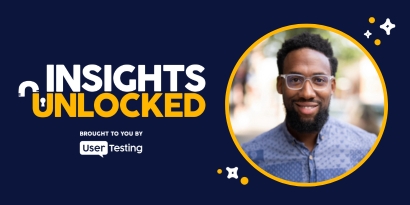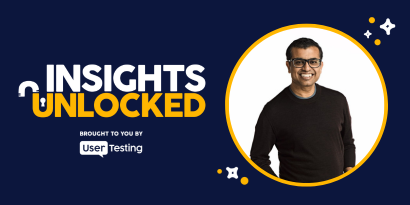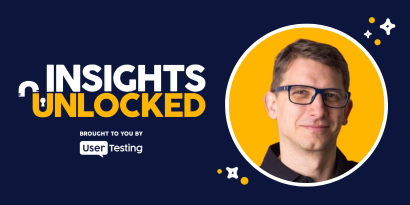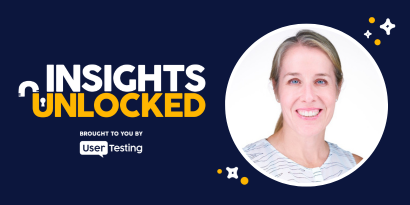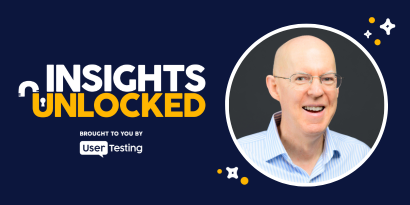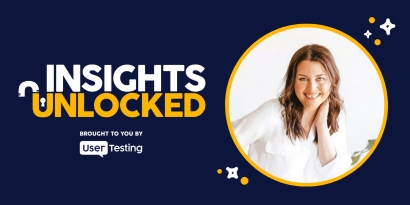
Episode 40 | May 16, 2022
Product research and empathy with C. Todd Lombardo
Discover how C. Todd Lombardo uses product research, empathy, and agile leadership to build better B2B experiences in this episode of Insights Unlocked.
Navigating uncertainty and building better products with research, empathy, and agility
“The biggest thing is how do you deliver value to a customer and a business at the same time?” – C. Todd Lombardo
As a product leader, uncertainty isn’t just part of the job—it is the job. The best product leaders don’t just survive ambiguity—they harness it, using customer feedback and cross-disciplinary research to fuel innovation. That’s the core message from C. Todd Lombardo, VP of Product & Experience at Openly, in this Insights Unlocked episode.
With a background that spans biotechnology, engineering, design, and business, Lombardo brings a systems-thinking mindset to product development. His insights offer a roadmap for anyone aiming to lead with empathy, curiosity, and a whole lot of strategic know-how.
Let’s unpack the key takeaways from this conversation—and what they mean for product managers, UX designers, marketers, and researchers alike.
The evolving role of product management: glue, guide, and guardian
Lombardo compares the product manager’s role to glue—holding together a constellation of functions that must align to deliver customer value and business results. While the tools may evolve, the fundamentals of product management remain unchanged.
“You're kind of like gluing all this together and saying, hey, there is this product we're trying to deliver to market to solve some problem for a customer—but also do it in a way that's going to make us some money,” Lombardo explains.
In a world of hybrid teams and shifting work cultures, product managers are now part conductor, part therapist, and part strategist. They’re tasked with managing not just timelines and roadmaps, but also the emotional terrain of uncertainty that permeates modern teams.
ON-DEMAND WEBINAR
Continuous discovery: transform your product development process
Why systems thinking is your secret product weapon
Lombardo’s career in biotechnology taught him the value of systems thinking—a discipline that’s all about zooming out to understand how various parts of a system interact. That’s incredibly relevant for product development.
Just like a chemist studies how molecules interact in different environments, a product manager must observe how user research, UX design, engineering, marketing, and business goals dynamically impact each other. Focusing on isolated features or metrics misses the broader picture.
“You have to be a systems thinker... it’s a really good skill set to have when it comes to design and product,” he said.
Beyond user research: a holistic approach to product research
If “garbage in, garbage out” applies to AI, it definitely applies to product sprints too.
Lombardo co-authored Product Research Rules to spotlight a critical gap in product workflows: research doesn’t start with the usability test—it starts long before that. He emphasizes integrating user research, market research, and analytics into one coherent product research strategy.
Here’s why that matters:
- User research tells you what people are doing and why.
- Market research tells you where your product fits in the competitive landscape.
- Analytics tell you how your product is performing.
“We’re not trying to break new ground, but there’s a gap in the conversation,” Lombardo says. “We’ve worked on failed products ourselves. We kept asking, ‘Why do we keep doing this to ourselves?’ The answer is: not enough research.”
Empathy isn’t soft—it’s strategic
Lombardo’s philosophy is rooted in empathy—not as a buzzword, but as a guiding principle for human-centered design. He argues that teams building products should be the ones conducting user research, not outsourcing it.
Why? Because when you hear a customer’s frustration firsthand, it becomes personal. That feedback embeds itself in your design choices, roadmap priorities, and team culture.
“It shouldn’t be a ‘do it for me.’ It should be a ‘do it with me,’” he says of working with UX research teams.
Lombardo likens bad research handoffs to a game of telephone. Each layer of interpretation risks stripping away nuance and emotional resonance. Instead, his teams embrace a participatory model where everyone has a stake in gathering and interpreting customer insights.
The power of remote tools and unfiltered feedback
You might think that virtual meetings dilute human connection—but when it comes to remote user testing, the opposite can be true.
Lombardo shares a fascinating anecdote from Product Research Rules about a couple who started arguing about finances during a virtual interview. Because the researcher wasn’t physically present, the couple felt freer to drop social niceties—resulting in raw, deeply insightful feedback.
“They got better insights because the couple actually, like, shed those niceties we often have when we’re in front of other people,” he said.
This phenomenon isn’t limited to one case. Tools like Zoom, Slack, and unmoderated user testing platforms have made it easier to connect with users more frequently and authentically—especially in B2B contexts where feedback was once gated by office visits and formalities.
Synthesizing feedback and getting buy-in across the org
Gathering feedback is only half the battle. Synthesizing it into actionable insights—and convincing the broader organization to act—is where many product teams stumble.
Lombardo advocates for bringing stakeholders along the journey rather than surprising them with conclusions at the end. This participatory approach ensures alignment and builds trust.
He outlines a smart framework for executive involvement in a design sprint:
- Join the kickoff to shape assumptions
- Review sketches and concepts mid-sprint
- Attend the final insights presentation with user feedback clips
“Include them. Let them co-create. That visibility into the journey helps make the outcome more credible,” he advises.
He also suggests starting presentations with conclusions before diving into how the team arrived there—avoiding misinterpretations and ensuring alignment from the outset.
The cost of skipping product research
If empathy and user insights sound like “nice-to-haves,” Lombardo offers a compelling financial rebuttal.
“Have you heard of Quibi? That was 1.7 billion with a B, and that also went nowhere,” Lombardo said.
He dubs these cautionary tales “ego-driven development.” The takeaway? No company is too big or too well-funded to fail—especially when it skips the fundamentals of product research and customer feedback.
Creating delightful experiences through small wins
Lombardo also shares two personal experiences that highlight the power of small, delightful moments—whether it’s serendipitously running into a friend on a ski trip or using a smart restaurant ordering system that remembers your details.
The key to great digital experiences? Exceeding expectations, even in small ways.
“In both cases, my expectations were surpassed in a positive way,” he said. “And that’s what makes a great experience.”
Looking ahead: what’s next for product and experience leaders?
So, what’s the future of product look like? For Lombardo, it’s not NFTs or the metaverse—it’s about bridging the digital and physical worlds in more human ways.
“Technology is never going to slow down,” he said. “But the fundamentals of product won’t change. What excites me is how we can use tech and data to keep improving lives—and still maintain a sense of connection.”
Prepare to be wrong—and learn from it
C. Todd Lombardo leaves us with a final piece of advice that every product leader should internalize:
“Prepare to be wrong. Because you’re probably going to be wrong in some way. The question is: how much?”
Whether you’re leading a product team, crafting UX strategies, or shaping brand campaigns, the lesson is the same: empathy, research, and collaboration aren’t just tools—they’re the compass guiding you through product uncertainty.
